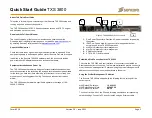
19
4-3. F
oundation
Fieldbus™ technology
The Foundation Fieldbus™ (FF) is a purely digital, serial communication system that
connects fieldbus devices (sensors, actuators), automation and process control systems with
each other. As a local communications network (LAN) for field devices the FF was primarily
designed for the requirements of process technology. The FF thus forms the basic network
throughout the hierarchy of a communication system.
4-3-1. System architecture
The following figure shows an example of a Foundation Fieldbus™ network with the
associated components.
Visualisation and monitoring
and diagnostic software
High speed Ethernet
(HSE) 100 Mbit/s
32 devices per segment
Field controller
linking
device
linking
device
linking
device
H1
31.25 kbit/s
H1 IEC 61158-2
H1 FISCO
Measuring point with
installed FF head transmitter
Measuring point with
installed FF head transmitter
Fig. 4-3. System integration via F
oundation
Fieldbus™
HSE = High Speed Ethernet, H1 = Foundation Fieldbus-H1
The following system connection options are possible:
- A linking device can be used to connect to higher ranking fieldbus protocols (e.g. to the High
Speed Ethernet - HSE) (Control Net)
- A H1 card is required for direct connection to a process control system.
- System inputs are available directly for H1 (HSE).
The system architecture of the Foundation Fieldbus™ can be divided into two
subnetworks:
H1 bus system:
In the field, fieldbus devices are connected only via the slower H1 bus system that is specified
following IEC 61158-2. The H1 bus system allows simultaneous feed to the field devices and
data transfer on the two-wire line.
The following points describe some important characteristics of the H1 bus system:
All fieldbus devices are powered via the H1 bus. Like the fieldbus devices, the power
supply is connected in parallel to the bus line. Devices requiring external power must use a
separate power supply.
















































